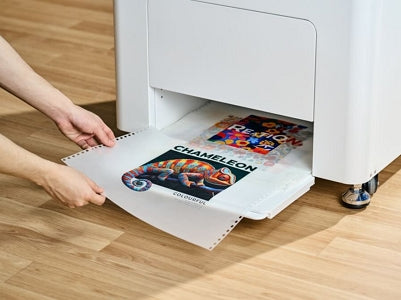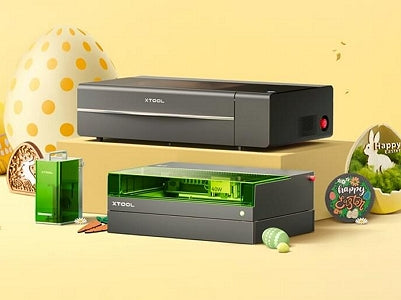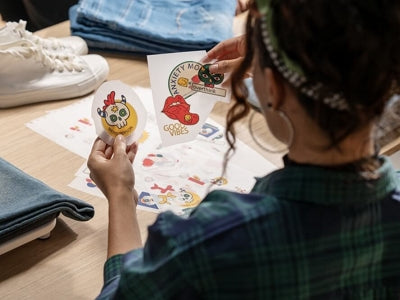How to Make Jewelry – A Guide for Beginners
Jewelry making has always been an interesting art– a challenging craft but financially rewarding. Due to metal inclusion, the craft has largely been practiced by skilled metalsmiths. However, modern tools like laser cutters have democratized the process and opened the path for hobbyists to make jewelry at home.

This guide explains the jewelry-making process, especially for beginners. We will list the tools, materials, techniques, and toturials to make your own jewelry.
In This Article
- Choose Your Jewelry Type
- Prepare Jewelry Making Tools and Supplies
- Learn the Basic Jewelry Making Techniques
- Start Making Your Jewelry
- Conclusion
Choose Your Jewelry Type
Jewelry comes in all shapes and sizes, each made to decorate different body parts. You’ve got necklaces, bracelets, earrings, rings – the list goes on. And with each type, there are tons of design options to play with. So, the first step is to shortlist and focus on just one type.
Next, is the design phase. As a beginner, you should start with simple designs. Try making something from common materials like beads or wire. For instance, you can make beaded bracelets or necklaces. Or, if you have a plain piece of jewelry, like a pendant or ring, customize it through engraving.
Jewelry Design Resources
Pinterest is a great place to start; it’s full of creative inspiration, with countless boards dedicated to jewelry designs from all over the world. Browse through different styles and save the ones you like for future reference.
Etsy is another fantastic resource. It is a marketplace for handmade items, including jewelry, so you’ll find plenty of personalized and unique jewelry designs. You can even find laser-cut designs if you’re interested in that.
Design Find is an excellent resource if you’re looking to explore the craft with a laser cutter. There are plenty of free design templates and projects that xTool users have shared. It has community forum as well; you can request help or get feedback from experts on your designs.

Prepare Jewelry Making Tools and Supplies
Once you’ve decided what to make, start gathering the supplies for your project. You’ll need some mechanical tools and material supplies, though they will vary from project to project.
Basic Mechanical Tools

As a beginner, you may need these mechanical tools to make jewelry:
- Pliers: For bending and shaping wires or holding small pieces. Get both round-nose and flat-nose pliers. The former helps in bending wires while the latter one is for gripping.
- Wire Cutters: These are pliers with sharp edges designed to cut through wire cleanly.
- Looms: A loom is a frame or board with pegs that hold threads or wires in place. It is used for weaving beads into patterns to create bracelets or necklaces.
- Wire Jigs: A small board with pegs that can be arranged in different patterns. It helps create consistent shapes and patterns by wrapping the wire around the pegs.
- Beading Needles: Long, thin needles for threading beads onto thin wire or string.
- Tumblers: A tumbler is a rotating barrel filled with small abrasive materials. It helps polish metals for a shiny finish.
- Files: Small, handheld tools with rough surfaces, used to smooth and shape rough edges on metal pieces.
- Jeweler’s Saw: A small saw with a fine blade, for cutting precise shapes out of metal sheets. The frame holds the blade tight for detailed cutting.
Modern Tools: Laser Cutters
Laser cutters have been a game-changer for jewelry makers. These small desktop machines use a laser beam to cut and engrave a wide range of materials with precision. You can easily cut popular jewelry materials like wood, leather and acrylic and even engrave metals with fine detail. Any design you have in mind can be perfectly executed with a laser cutter.

Laser-cut jewelry
Basic Materials for Jewelry Making

image credit: freepik
The material choices in jewelry making are vast, and it’s impossible to cover everything, but here’s a brief list of the most common materials and their diversity:
- Beads: Beads come in many shapes, sizes, and materials, including glass, plastic, wood, metal, and gemstones. You can find seed beads, crystal beads, pearl beads, and many more designs.
- Wire: Jewelry wire is available in different materials (copper, silver, gold, and stainless steel). It comes in various gauges (thicknesses) to suit different types of jewelry.
- Chains: Chains are a fundamental part of many jewelry designs, available in diverse styles like cable, rope, box, and curb chains. They come in gold, silver, and plated varieties.
- Jewelry Findings: Findings are the small components that connect or complete a piece of jewelry. This includes clasps, jump rings, earring hooks, and headpins.
- Cords and Threads: Used for stringing beads or creating woven jewelry. They can be made from silk, nylon, cotton, or leather.
- Cabochons: These are polished stones or glass pieces with a flat back, used for setting in rings, pendants, or earrings.
- Resin: This material is used to create custom shapes, fill molds, or encase objects in a clear, hard finish. It can be mixed with dyes, glitters, and other inclusions to create unique pieces.
- Crystals and Gemstones: These are used as focal points in jewelry. Crystals like Swarovski and natural gemstones such as amethyst, turquoise, or quartz are some popular names.
Jewelry Making Kits
If you’re just starting out, a convenient way is to choose jewelry making kits. These kits have all the small components you need to complete specific projects. So, you don’t have to shop around and collect each item individually. Many of these kits also include tutorials that guide you through the process step by step.

image credit: tobabrighton.com
Sources for Tools and Supplies
Where to get these mentioned supplies? Try out these sites:
Fire Mountain Gems: A great place for jewelry making supplies and tools. They have a variety of beads, gemstones, and basic tools to get you started.

Rio Grande: This is your go-to for high-end jewelry materials. They offer everything for metal jewelry products, from metal findings to diamonds and gold chains.

Etsy: Etsy is a marketplace where you can find a lot of unique jewelry supplies. Raw materials, and decorative elements – there’s a huge collection of these items on Etsy.
xTool: xTool is the best place to get laser cutting and engraving machines. You can also find plain steel pendants, chains, earrings, and other jewelry-making supplies on their material store.
Learn the Basic Jewelry Making Techniques
Finally, let’s explore some trendy jewelry-making techniques. We have segregated them based on materials.
Metalworking Jewelry Making Techniques

image credit: master1305 - freepik
Metals, especially gold, are a symbol of premium jewelry. This type of jewelry does require a professional. Here’s a basic review of techniques used in metalworking:
- Wirework: It is all about bending and shaping wire into different forms. You can twist, loop, and wrap the wire to create earrings, bracelets, and pendants.
- Soldering: The process of joining metal pieces together using heat and a filler metal called solder. It’s a must-know for making rings, chains, and jewelry that need seamless connections.
- Casting: Casting is pouring molten metal into a mold to shape jewelry. Unique designs can be casted out of metals with it.
- Forging: Forging is the art of shaping metal by hammering it. This technique is used to make solid pieces like bangles or cuffs, where the metal is hammered into shape.
- Stamping: Stamping is when you use metal stamps to imprint designs or letters onto metal. It's an alternative to engraving. Perfect for customizing jewelry with your names, or logos.
- Enameling: Enameling adds a splash of color to metal by applying powdered glass and then firing it. This creates a smooth, colorful finish, often seen on earrings, brooches, and decorative pendants.
Stone Setting Techniques

image credit: freepik
Stones give a premium feel and class to jewelry. To stylize and fix these stones in jewelry, these techniques are employed:
- Prong Setting: The method that uses small metal claws (prongs) to hold a stone in place. A common technique for making engagement rings that come with a stone in the center.
- Bezel Setting: Bezel Setting: Wrapping a thin metal strip around the edge of a stone to keep it secure. It’s a solid option if you want to protect the stone and is often used in rings and pendants for a sleek and sturdy look.
- Channel Setting: Placement of stones side by side in a groove or channel between two metal walls. This method is used in wedding bands, creating a clean, continuous row of stones that sit flush with the metal.
- Pavé Setting: This setting is all about covering a surface with small stones. Tiny beads of metal hold the stones close together, giving the jewelry a sparkling, paved look. It is common in rings and bracelets.
Other Popular Techniques
Now, here are some other techniques, usually practiced by DIYers:
Resin Casting: The pouring of liquid resin into molds, sometimes with small objects or decorations inside. Once it hardens, you get a unique, clear piece of jewelry.

image credit: LuckFindingsStore - Etsy
Clay Jewelry: This technique uses clay that you can mold into different shapes. After shaping, the clay is fired in a kiln or baked in an oven to harden. It’s great for making custom beads, pendants, and charms.

image credit: Keoker - Etsy
Macrame: Knotting cords or strings in patterns to create jewelry. It’s a cool way to make bracelets, necklaces, and even earrings, often with a rustic vibe.

image credit: Mais Jewelry - Etsy
Leather Crafting: Cutting and shaping leather into various components for jewelry. You can use it to make bracelets, necklaces, or earrings with a more natural, earthy look.

laser-cut leather earrings
Resources for Learning Jewelry Making
Want to learn the art of jewelry making? These few resources will definitely help:
YouTube: Estona Metalsmithing YT channel has over 100 videos and is run by an experienced metalsmith. They focus on ring-making and related stuff. Andrew Berry is another goldsmith on YT with 35 years of experience. He shares videos on gemstones and metal jewelry. You can also check out Soham Harrison and Lucy Walker for more tutorials.
Communities: Join jewelry-making communities on Facebook, Instagram, or a dedicated platform like Design Find to connect with other creators and get advice.
Online Courses: Online Jewelry Academy has fully structured and comprehensive courses on various jewelry-making techniques. Udemy also has multiple courses on how to make jewelry.
Books: Read Complete Metalsmith by Tim McCreight, and Professional Jewelry Making by Alan Revere.
Start Making Your Jewelry
With everything in place now, start building your jewelry. Here’s one of the earring projects we made with a laser cutter. Follow these steps to create stunning earrings like we did:
1. Get the Material and Prepare the Machine

To start, you will need 3mm acrylic sheets. Choose colors as per your taste. Next, set up the laser cutter. Add a honeycomb panel inside and connect it to your PC.
2. Import Your Designs

Open the XCS (xTool Creative Space) software and import the earring designs you plan to use. Could be any design of your choice. But make sure to adjust its size to fit in the earring size.
For earrings, you need a pair of designs. To achieve that, duplicate the design and reflect it horizontally so that your earrings are mirrored.
Select the material in the software and define settings for cutting. You may also use preset values.
3. Laser Cut the Earrings

Place the acrylic sheet on the machine bed. Use the camera feature to position the design on it. And use the auto-measure feature to ensure the thickness (laser head focus) is correctly set. Start the cutting process by hitting the "Process" button.
Note: If your design involves engraving, ensure this step is completed during the cutting process as set up in XCS.
4. Assemble the Earrings

Once the pieces are cut, carefully remove them from the acrylic sheet. Assemble the earrings by attaching earring hooks or other findings to complete the pair.

Conclusion
Everyone loves wearing jewelry, but some aspire to create their own customized pieces. Thankfully, it’s not a tough job anymore. If you love making things, try getting a laser cutter or a DIY jewelry-making kit. With this guide as your mentor, we’re confident you can source materials and craft something unique.
Don’t forget to share your creations with us through Design Find!





